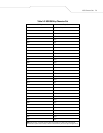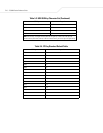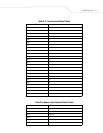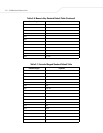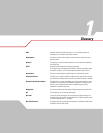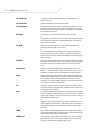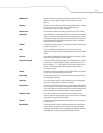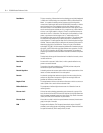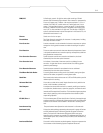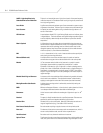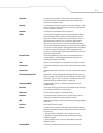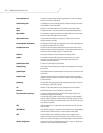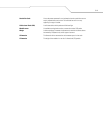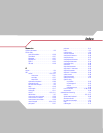
DS 6608 Product Reference GuideGL-4
Data Matrix This error correcting, 2-dimensional matrix symbology was originally developed
in 1989, and a finalized design was completed in 1995 by International Data
Matrix. It's capable of encoding various character sets including strictly
numeric data, alphanumeric data and all ISO 646 (ASCII) characters, as well as
special character sets. The symbology has both error detection and error
correction features. Each Data Matrix symbol consists of data regions, which
contain nominally square modules set out in a regular array. A dark module is
a binary 1 and a light module is a binary 0. There is no specified minimum or
maximum for the X or Y dimension. The data region is surrounded by a finder
pattern, a perimeter to the data region that is 1 module wide, which is
surrounded by a quiet zone on all four sides of the symbol. Two adjacent sides
are solid dark lines used primarily to define physical size, orientation and
symbol distortion. The two opposite sides consist of alternating dark and light
modules. These are used primarily to define the cell structure but also assist in
determining physical size and distortion. There are 2 types of Data Matrix
symbologies: ECC 000 - 140 with several available levels of convolutional error
correction, and ECC 200, which uses Reed-Solomon error correction. For ISO/
IEC JTC 1/SC 31 purposes, only ECC 200 is recommended. The intellectual
property rights associated with Data Matrix have been committed to the public
domain.
Data Structure The stipulation of the type of information that is included in a bar code, such as
its order and format.
Dead Zone An area within a scanner's field of view, in which specular reflection may
prevent a successful decode.
Decode To recognize a bar code symbology (e.g., UPC/EAN) and then analyze the
content of the specific bar code scanned.
Decode Algorithm A decoding scheme that converts pulse widths into data representation of the
letters or numbers encoded within a bar code symbol.
Decoder An electronic package that receives the signals from the scanning function,
performs the algorithm to interpret the signals into meaningful data and
provides the interface to other devices.
Depth of Field The range between minimum and maximum distances at which a scanner can
read a symbol with a certain minimum element width.
Diffuse Reflection The component of reflected light that emanates in all directions from the
reflecting surface.
Discrete 2 of 5 A binary bar code symbology representing each character by a group of five
bars, two of which are wide. The location of wide bars in the group determines
which character is encoded; spaces are insignificant. Only numeric characters
(0 to 9) and START/STOP characters may be encoded.
Discrete Code A bar code or symbol in which the spaces between characters (intercharacter
gaps) are not part of the code.
EAN European Article Number. This European/International version of the UPC
provides its own coding format and symbology standards. Element dimensions
are specified metrically. EAN is used primarily in retail.




